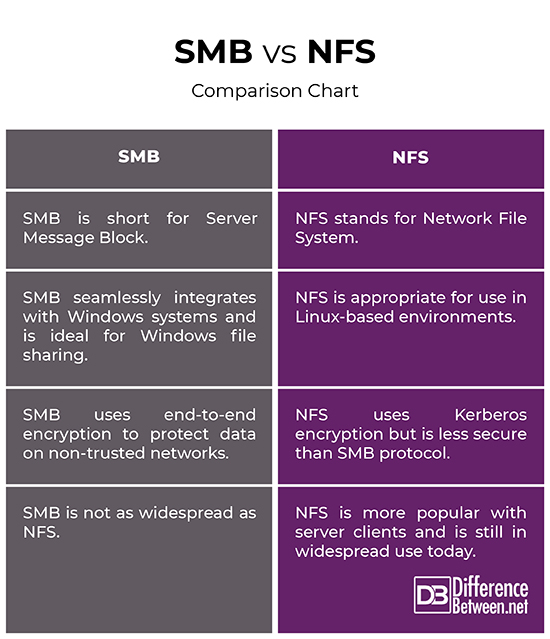Difference Between SMB and NFS
If you want to share files over a local network, whether your network uses a peer-to-peer, client/server, or some hybrid design, there are two main solutions you can choose from: NFS and SMB. Both are client-server communication protocols that allow you to access files on a remote server. Both are often used in many network environments to share files to and from file servers. We take a look at some functional differences between the two.

What is SMB?
SMB, short for Server Message Block, is a client-server communication protocol that provides shared access to network files and resources between nodes on a network. It basically is a network file sharing protocol that enables you to communicate with remote computers or servers. Simply put, SMB lets you share files over a network. Let’s say you’re using your laptop and you want to use a printer connected to the company’s computer. So, when you print a document, your laptop used the SMP protocol to send the print request to the company’s computer. Your laptop then receives a response whether the document is being printed or not.
SMB is mainly a native file sharing protocol for computers running on Microsoft Windows. It seamlessly integrates with Windows operating systems. SMB was originally created by IBM and modified by Microsoft in mid-1990s. Microsoft continued improving the protocol; SMB 2.0 improved the performance and the SMB 3.0 increased the performance. SMB 2.0 was introduced by Microsoft for the Windows Vista and was a major rewrite of the original protocol. Microsoft tried to change the name of SMB to CIFS but the name didn’t catch on and future versions used and still use the name SMB.

What is NFS?
NFS, short for Network File System, is a file service protocol that enables users to access files on a remote server, making it a distributed file system. It allows a computer on which the NFS server is running to export its file systems to other clients, which means it is made available to clients on different OS platforms. It uses server-client architecture to provide multiple computers access to files over a local network. NFS was designed for UNIX systems and thus, includes support for UNIX filesystem features, such as ownership and UNIX-style permissions.
NFS was originally developed by Sun Microsystems in the early 1980s and has been licensed to more than 200 vendors. NFS Version 1 was used internally by Sun and was never released. The Version 2 provided basic network file sharing and was used extensively with UNIX based systems. Version 4 was released in Dec. 2000 and was the first version developed with the Internet Engineering Task Force (IETF) after Sun handed over the NFS protocols to IETF. This is also a lot more secure than previous versions.
Difference between SMB and NFS
Protocol
– Both SMB and NFS are common file sharing protocols often used in many network environments to share files to and from file servers. SMB is a native file sharing protocol for computers running on Microsoft Windows and is used for sharing access to resources on a network. NFS is also a file service protocol that enables users to access files on a remote server, allowing a computer on which the NFS server is running to export its file systems to other clients.
Platform
– SMB is a native file sharing protocol that Microsoft Windows clients use to access file servers. It seamlessly integrates with Windows systems. Many LINUX and UNIX clients also use SMB via Samba. NFS was designed for UNIX systems and thus, includes support for UNIX filesystem features, such as ownership and UNIX-style permissions. NFS is more suitable for UNIX-to-UNIX file sharing than SMB. However, you can also use NFS in a mixed environment of UNIX and non-UNIX systems.
Security
– While both are not very safe to use in hostile networks such as the Internet, the security vulnerabilities with NFS protocol is more compared to SMB. SMB uses advanced encryption standard for transmitted data and uses end-to-end encryption of SMB data and protects data from eavesdropping on non-trusted networks. NFS authentication is less secure than SMB. NFS uses Kerberos encryption but is less secure than SMB protocol.
SMB vs. NFS: Comparison Chart

Summary
Both SMB and NFS are server-client communication protocols and are often used in many network environments to share files to and from file servers. However, SMB seamless integrates with Windows systems. This means if you are connecting two Windows computers together, it is appropriate to use the SMB protocol. NFS, on the other hand, is more suitable for UNIX-to-UNIX file sharing, meaning if you connect two UNIX computers together, you’d like to use NFS protocol for file sharing. If you have a NFS server deployed on a UNIX system, you can still access the NFS server with Windows. However, both protocols can work on any mainstream operating system.
Is SMB better than NFS?
Both SMB and NFS are client-server communication protocols used for sharing data over a network. SMB is best for Windows file sharing whereas NFS is ideal for Linux-based environments. SMB is, however, more secure than NFS in terms of data security.
What is NFS and SMB file system?
NFS is a distributed file system protocol that enables users to access files on a remote server much like you’d access local storage files. SMB is pretty much the same and enables access to remote computers and servers by allowing users to use their resources or share, edit files.
Which is faster Samba or NFS?
NFS is a network file system protocol whereas Samba is a networking tool for Windows and UNIX users to access file and print services. Samba is a bit slower than NFS but is easy to set up and use.
What is SMB used for?
SMB is a client-server communication protocol that Windows clients use to access file servers and other resources on a network. It can be used on top of the TCP/IP protocol or other network protocols.
- Difference Between Caucus and Primary - June 18, 2024
- Difference Between PPO and POS - May 30, 2024
- Difference Between RFID and NFC - May 28, 2024
Search DifferenceBetween.net :
Leave a Response
References :
[0]Smith, Roderick W. The Multi-boot Configuration Handbook. Seattle, United States: Que Publishing, 2000. Print
[1]Dwivedi, Himanshu. Implementing SSH: Strategies for Optimizing the Secure Shell. New Jersey, United States: John Wiley & Sons, 2003. Print
[2]Siyan, Karanjit. Windows 2000 TCP/IP. Indiana, United States: Sams Publishing, 2000. Print
